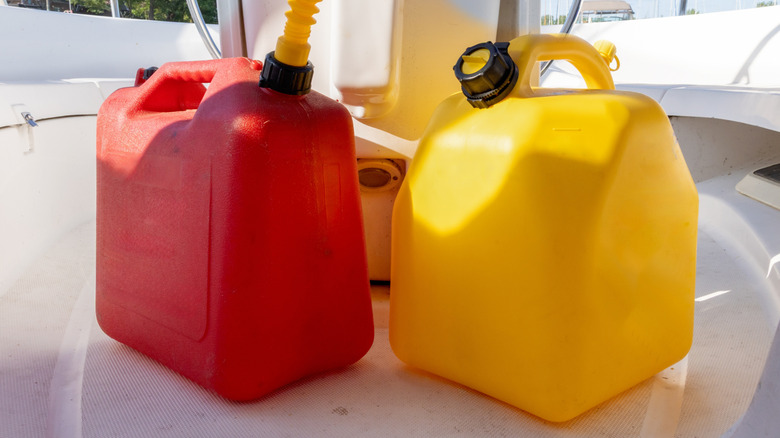What To Do If You've Put The Wrong Fuel In A Lawnmower
When choosing between a gas versus electric lawn mower for your yard, there's plenty of reason to consider the former. Gas models run longer (a benefit for those with large yards) and generally cost less upfront. However, you will need to perform more maintenance to keep these units in top operating condition. In addition to performing maintenance like oil changes and air filter replacements, you need to be certain you are choosing the right gas for your lawn mower. If you inadvertently place the wrong gas type in your mower, you'll need to take certain immediate steps to protect the engine, such as draining the fuel from the fuel line or carburetor or having a professional flush the entire system. This all depends primarily on the type of fuel you accidentally added.
For example, there's rarely a need to place high-octane premium gas in your lawn mower, as it can't take advantage of this fuel's ability to deliver extra performance like a high-end motor vehicle can. The good news is adding premium fuel won't ruin your mower's engine; it'll just waste your money. You also shouldn't place ethanol-blended gasoline into your lawn mower. Ethanol could damage plastic and rubber motor parts while corroding the fuel system over time. Ethanol-free, regular unleaded gas is perfect for most mowers. If you inadvertently use an ethanol blend, you can add a fuel system cleaner product to the tank to flush and refresh the components. These are many of the same steps you should take when changing the gas in your lawn mower to keep the fuel fresh after the machine sits idle.
Adding diesel fuel to a lawn mower requires immediate action
If you have diesel fuel at your home for use in certain types of machines or vehicles, it's important not to add it to a motor designed for regular gasoline. Diesel and gas are different fuels that are not interchangeable. Placing thicker diesel in a gas-powered engine will cause damage like clogging the engine's fuel filter and the lawn mower's carburetor. It's recommended that you store diesel in a yellow can and regular gasoline in a red can, clearly labeling them if needed to ensure that you don't accidentally confuse the two.
If you place diesel in the mower's engine, never start and operate it. Drain the tank by disconnecting the fuel line from the carburetor. If you can't gain access to the line, use a siphon or turkey baster to pull the diesel out of the tank. Place the drained fuel in an approved container or gas can. Replace the fuel filter and spark plug. You could then try using carburetor cleaner in a quick and simple method to clean your lawn mower's carburetor. Following that, run the engine with fresh gasoline and hope it will burn off the remaining diesel. It probably will generate smoke during this process. If it won't start, have a professional clean the diesel out of the system.
What should you do if you aren't quite sure whether you added diesel to the lawn mower's tank? You can use a turkey baster to pull some of the fuel from the tank and place it in a container to inspect it. Diesel is denser and more oily, while regular gas has a sharper smell and a consistency closer to water.
Adding an oil-and-gas mixture isn't as dangerous for mowers
Most lawn mower engines are four-stroke designs, which follow four steps to operate — intaking fuel, compressing the fuel, igniting the fuel, and releasing exhaust gases. Ethanol-free regular gasoline is the best fuel to use with most four-stroke lawn equipment engines. You might have some other outdoor power tools at your house that use two-stroke engines, such as chainsaws, leaf blowers, and string trimmers. A two-stroke engine is used in tools that need less operational power. It needs two steps to operate — compressing and igniting the fuel in one step and releasing the exhaust gases in the second step. The two-stroke engine doesn't have a separate chamber or port for oil that lubricates the parts of the motor like the four-stroke engine has, so you have to mix oil and gas in a precise ratio to run in the two-stroke engine.
Inadvertently placing a two-stroke oil-and-gasoline mixture in a four-stroke lawn mower is not ideal, but this mistake shouldn't harm the engine. If you catch the error early enough, you could drain the two-stroke fuel into an approved container and refill the tank with regular gasoline. If you don't catch the problem early, you can probably safely burn some of the oil-and-gas mixture while topping off the tank with the correct regular gasoline every several minutes to try to dilute the oil concentration in the tank. Burning the two-stroke fuel in the four-stroke motor may ruin the spark plug, so you'll have to replace it, and it will likely generate noticeably smoky exhaust.


